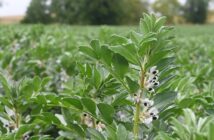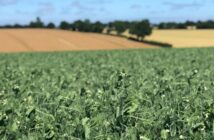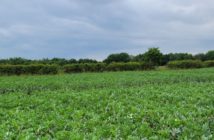The area of pulses grown this spring and autumn will increase as growers turn to beans and peas to meet the new CAP greening requirements, manage blackgrass and mitigate falling oilseed rape prices.
“As growers look for the most practical ways to meet the 5% EFA requirement in CAP greening, we are likely to see an increase in the pulse area of up to 30%,” explains BEPA (British Edible Pulse Association) President Andy Bury. “At a farm level, this is surely driven by the fact that pulse crops are profitable in their own right, giving gross margins that match, and exceed, other combinable crops. Both spring and winter beans as well as marrowfat and blue peas all give gross margins comparable to or well over those of feed wheat, milling wheat, spring wheat and spring malting barley.
“Also, a pulse crop will have a positive effect on the whole farm rotation, providing substantial benefits to subsequent crops – particularly cereals or oilseeds – providing a disease break and requiring no nitrogen fertiliser.”
“The general outlook for pulses in the UK is looking very optimistic for harvest 2015 with buyers once again looking forward to seeing plentiful supplies matched with good demand for an increased crop. While it might be felt that a greater acreage will put downward pressure on prices, that should not be a concern. Prices will be slightly lower, but the real point is that there will be a reduction of the premium of feed beans over wheat – and this will bring more buyers into the market – with increasing demand bringing new opportunities for growers. Indeed, UK demand from UK compound mills for ruminant and pig rations is likely to return, and this is coupled with rising demand likely in southern Europe. Additionally, as feed bean prices get closer to wheat values, demand from the aquaculture sector is increasing.
“Export demand for UK human consumption beans is also growing as population growth in North Africa fuels market growth. The UK, France and Australia are the only three countries that grow beans for human consumption for the Egyptian market – with UK spring beans always considered a premium product over French beans.
“For peas, 2015 market values will be at least £300/ tonne for marrowfats, against just £160 for feed peas. Large blues are also likely to be plentiful, so we would expect values to be close to £200 tonne. This wide differential is due to the fact that marrowfats are a very specialist crop and require a very high level of technical input in order to produce quality samples. More importantly, they are only grown in a small area in the UK and demand for the product is static in the UK – mostly for mushy peas. The real growth area is in the Far East where buyers are queuing up to buy more product – but with limited supplies and no more seed for planting this year – this market will remain tight.
“Large blue peas are a quite different product – with plentiful supply from the UK, France and Canada, there is a large oversupply. Demand is limited in the UK as petfood buyers and coarse mix plants have reduced their usage due to high prices over the previous three years.
“The key watchword for all pulse growers growers must be ‘quality’ – with the price differential between human consumption and feed for both peas and beans ranging from £30/t to £100/t, pea and bean crops deserve maximum attention to deliver potentially the best gross margin of all combinable crops,” adds Mr Bury.



